Using advanced computer simulations, astrophysicists are learning how galaxies evolve their characteristic structure — super-bright centers fading away to dark edges.
Researchers from the University of Wisconsin–Madison, Iowa State University and IBM Research have discovered that massive clumps of gas within galaxies scatter some stars from their orbits, eventually creating a smooth, exponential fade in the brightness of many galaxy disks.
While the research team originally studied these orbital changes in young galaxies, they have now published a new paper showing that the process is robust and universal in all kinds of galaxies, including spiral galaxies like the Milky Way, dwarf elliptical galaxies and some irregular galaxies.
How can astrophysicists explain that?

This illustration shows how two sample star orbits are scattered from nearly circular orbits by the gravity of massive clumps within galaxies. The blue star is scattered several times. The orange star is captured by the gravity of a clump and moves around it. A typical, relatively smooth spiral galaxy is shown in the background. ILLUSTRATION BY JIAN WU; GALAXY IMAGE FROM THE SLOAN DIGITAL SKY SURVEY
By using realistic models to track star scattering within galaxies, “we feel we have a much deeper understanding of the physical processes that resolve this almost-50-year-old key problem,” says Curtis Struck, a professor of astronomy and physics at Iowa State who led the new study.
Gravitational impulses from massive clumps alter the orbits of stars, the researchers found. As a result, the overall star distribution of the disk changes, and the exponential brightness profile is a reflection of that new stellar distribution.
The astrophysicists’ findings are reported in a paper just published online by the Monthly Notices of the Royal Astronomical Society. Co-authors include Jian Wu, an Iowa State doctoral student in physics and astronomy, Elena D’Onghia, an associate professor of astronomy at Wisconsin, and Bruce Elmegreen, a research scientist at IBM’s Thomas J. Watson Research Center in Yorktown Heights, New York.
Read more about the latest findings on the Iowa State University news page.


